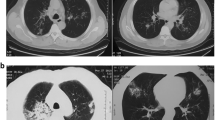Abstract
Propionibacterium acnes was identified as the pathogen in a case of subacute lung infection by examination of an open lung biopsy specimen. The patient was a 65-year-old male with exacerbation of chronic lung disease. The organism was isolated in pure culture and was present in large numbers on Gram stain. Histological examination demonstrated active interstitial fibrosis; macrophages laden withPropionibacterium acnes antigen were revealed using a peroxidase-antiperoxidase stain. This is the first report of subacute infection of pulmonary tissue due to this organism.
Similar content being viewed by others
References
Kligman AM: An overview of acne. Journal of Investigational Dermatology 1974, 62: 268–287.
Schlesinger JJ, Ross AL:Propionibacterium acnes meningitis in a previously normal adult. Archives of Internal Medicine 1977, 137: 921–923.
Brook I, Frazier EH: Infections caused byPropionibacterium acnes. Reviews of Infectious Diseases 1991, 13, 819–822.
Posenauer B, Funk J: Chronic postoperative endophtalmitis caused byPropionibacterium acnes. European Journal of Ophtalmology 1992, 2: 94–97.
Richard J, Ingham HR, Crawford PJ, Sengupta RP, Mendelow AD: Focal infections of the central nervous system due toPropionibacterium acnes. Journal of Infection 1989, 18: 279–282.
Haslett TM, Isenberg HD, Hilton E: Microbiology of indwelling central catheters. Journal of Clinical Microbiology 1981, 26: 697–701.
Felner JM, Dowell VR: Anaerobic bacterial endocarditis. New England Journal of Medicine 1970, 283: 1188–1192.
Schwarz DA, Finkelstein SD:Propionibacterium acnes cerebral botryomycosis. The role of plastic embedding in the diagnosis of grain-producing infections. American Journal of Clinical Pathology 1986, 82: 682–685.
Brown RC, Hopps HC: Staining of bacteria in tissue sections: a reliable Gram stain method. American Journal of Clinical Pathology 1973, 59: 234–240.
Cummins CS, Johnson JL:Corynebacterium parvum: a synonym forPropionibacterium acnes. Journal of General Microbiology 1974, 80, 433–442.
White RG: The macrophage-stimulating properties of a variety of anaerobic coryneforms. In: Alpern B:Corynebacterium parvum. Applications in experimental and clinical oncology (ed): Plenum Press, New York, 1975, p. 148–161.
Cummins CS, Stimpson SA, Tuttle RL, Weck CJ: Observations on the nature of the determinants in anaerobic coryneforms which produce splenomegaly. Journal of the Reticuloendothelial Society 1981, 29: 1–13.
Tuttle RL, North RJ: Mechanisms of antitumor action ofC. parvum: nonspecific tumor cell destruction at site of an immunologically mediated sensitivity reaction toC. parvum. Journal of the National Cancer Institute 1975, 55: 1403–1409.
Pringle AT, Cummins CS, Bishop BF, Viers VS: Fate of vaccines ofPropionibacterium acnes after phagocytosis by murine macrophages. Infection and Immunity 1982, 38: 371–374.
Webster GF, Leyden JJ, Musson RA, Douglas SD: Susceptibility ofPropionibacterium acnes to killing and degradation by human neutrophils and monocytes in vitro. Infection and Immunity 1985, 49: 116–121.
Pringle AT, Cummins CS: Relationship between cell wall synthesis inPropionibacterium acnes and ability to stimulate the reticuloendothelial system. Infection and Immunity 1982, 35: 734–737.
French RS, Ziter FA, Spruance SL: Chronic meningitis caused byPropionibacterium acnes. Neurology 1974, 24: 624–628.
Schlossberg D, Keeney GE, Lifton LJ, Azizhkan RG: Anaerobic botryomycosis. Journal of Clinical Microbiology 1980, 11: 184–185.
Bannister AB, Edwards S, Ibata G: Aetiology of Kawasaki disease. Archives of Diseases in Children 1989, 64: 397–398.
Kato H, Inoue O, Koga Y, Shinghu M, Fujimoto T: Variant strain ofPropionibacterium acnes: a clue to the aetiology of Kawasaki disease. Lancet 1983, ii: 1383–1387.
Abe C, Iwai K, Mikami R, Hosoda Y: Frequent isolation ofPropionibacterium acnes from sarcoidosis lymph nodes. Zentralblatt für Bakteriologie und Hygiene A 1984, 256: 541–547.
Stewart SM, McBride WH: Mycoplasms and ‘diphtheroids’ in rheumatic arthritis. Rheumatology 1975, 6: 329–333.
Author information
Authors and Affiliations
Rights and permissions
About this article
Cite this article
Claeys, G., Verschraegen, G., De Potter, C. et al. Bronchopneumonia caused byPropionibacterium acnes . Eur. J. Clin. Microbiol. Infect. Dis. 13, 747–749 (1994). https://doi.org/10.1007/BF02276058
Issue Date:
DOI: https://doi.org/10.1007/BF02276058




